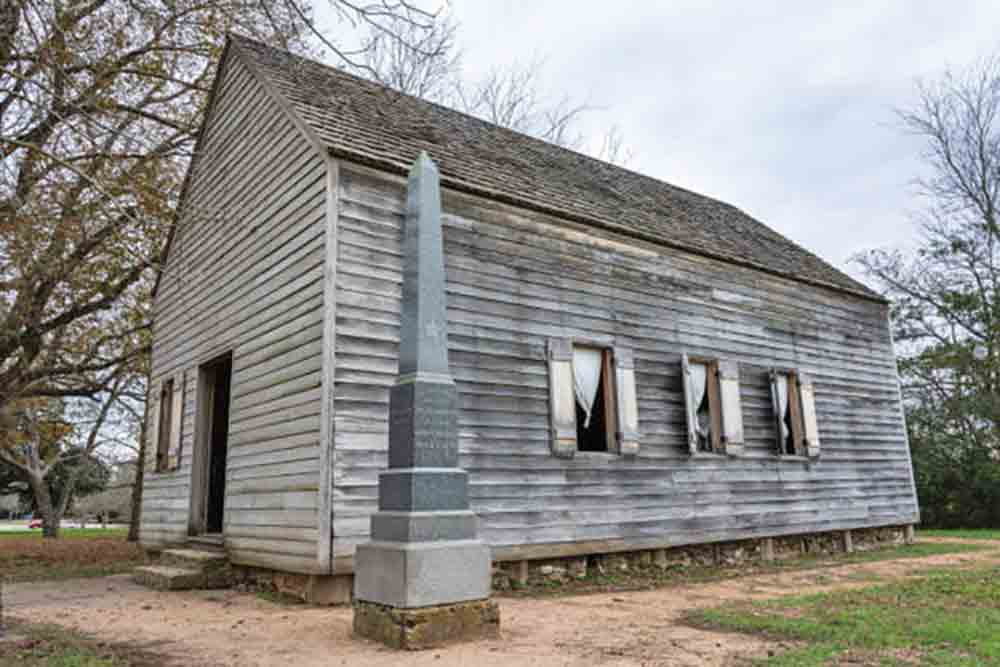 Independence Hall at Washington-on-the-Brazos. Image provided by the author
Independence Hall at Washington-on-the-Brazos. Image provided by the author
By Maureen Peltier
A Spanish cannon - the fight for Texas independence from Mexico, formally declared on March 2, 1836, began with a skirmish over a Spanish cannon.
The 6-foot-long cannon weighed 1,200 pounds and could shoot its projectile 1,600 yards. The iron cannon balls were approximately four inches in diameter, weighed six pounds and were shot using 1 ½ pounds of cannon powder. It was most likely built in Seville, Spain, yet this particular bronze battlefield gun ended up in October of 1835 near the present Texas town of Gonzales, south of Interstate 10 between San Antonio and Houston.
This particular cannon was a relic of an earlier war between Mexico and Spain for Mexican independence. When Spain lost, many of their cannons were left behind in Mexico. In spite of high tensions between settlers in Texas from the United States and natives of Mexico, in 1831 the Mexicans delivered this cannon to the town of Gonzales for the purpose of warding off Indian attacks, with the stipulation that it be returned upon request. According to the Texas State Historical Association, the fact that the gun was not carriage mounted until 1835 suggests that in 1831 the Texas settlers probably swivel mounted it in one of two perimeter blockhouses to serve as a visual deterrent to hostile Indians.
But in 1835 when the Mexican army sent soldiers to retrieve it, Texans put up a fight. Tensions had been mounting between the settlers from the United States and Mexico and the settlers saw no reason to give it back to Mexico. When a contingent of the Mexican army arrived, the Texans decided to hold their ground and keep the cannon. They adopted the now famous motto “Come and Take It” and hastily prepared a flag with a single star, an image of the cannon and those words. We do not know what happened to the original flag; we only know that it was carried wherever the cannon went. The Mexicans retreated after a number of their soldiers were captured and went away leaving the cannon behind. Afterward, the Texans buried the cannon in a peach orchard. When the Alamo became threatened, they dug it up, mounted it on the front wheels of a cotton wagon and took it to the Alamo where it was used to fight in that most famous battle.
From prior history leading up to 1836, we recall that in 1824 Mexico had adopted a constitution which was favorable to United States citizens moving to Texas to settle; however, when Antonio Lopez de Santa Anna became president, he abandoned the 1824 Mexico constitution and the country fell under his dictatorship, the result of which was Texan settlers realizing that living under the dictatorship of Santa Anna was increasingly unacceptable. Consequently, they elected delegates to a convention to gather in early March of 1836 at Washington-on-the-Brazos.
Related Articles
Forty-one delegates were present at the opening of the convention on March 1. Only two delegates were native Texans and one was born in Mexico City. The majority were from the United States, with a few from Europe. The group was young, with most under 40 years of age.
The delegates knew that they had only two choices - submit to the dominance and authority of Mexico or declare independence. On March 2, 1836 they choose independence.
Their next tasks were to draft a constitution, establish a strong provisional government and quickly prepare to defend themselves against the strong Mexican army fast approaching. Sam Houston, a former US congressman and governor of Tennessee, was chosen as commander-in-chief. He left the convention early to take charge of the forces gathering at Gonzales. David G. Burnett was elected provisional president.
Six days later, the Battle of the Alamo commenced, followed by a 13-day siege by Santa Anna’s army. Although all of the defenders died, the iconic battle cry “Remember the Alamo” rallied soldiers at the final battle of the Texas Revolution when Santa Anna was captured on April 21, 1836, at San Jacinto.
Texas won the independence which it had declared less than two months earlier.
For ten more years Texas remained a republic and had three other presidents - Sam Houston, Mirabeau Lamar and Anson Jones.
Without a doubt, pride is one thing we Texans possess, especially when we remember our history on Texas Independence Day. We love to hear about the courage of David Crockett, James Bowie and William Barret Travis at the Alamo, and Sam Houston’s capture of General Antonio Lopez de Santa Anna less than two months later at San Jacinto makes us even prouder to be Texan, but it is also well worth remembering that it all began with the determination of the proud settlers at Gonzales and the fight over that 6-foot Spanish cannon. The Texans refused to let the Mexico army come and take it.
You are a guest
or post as a guest
Be the first to comment.

